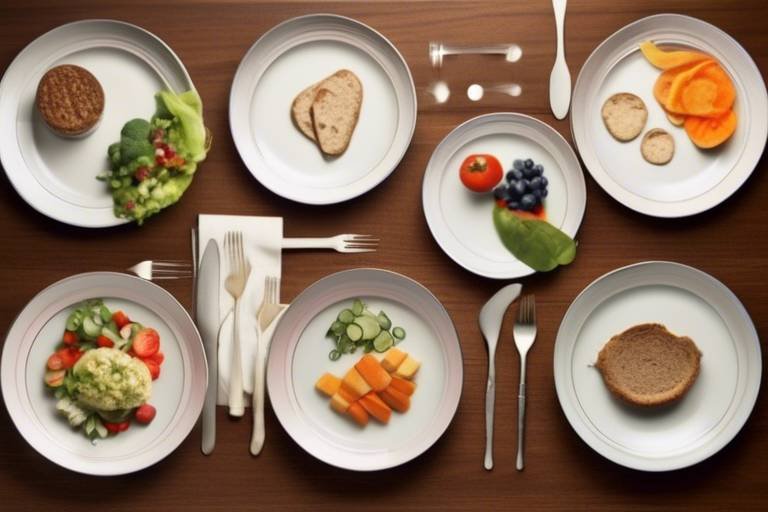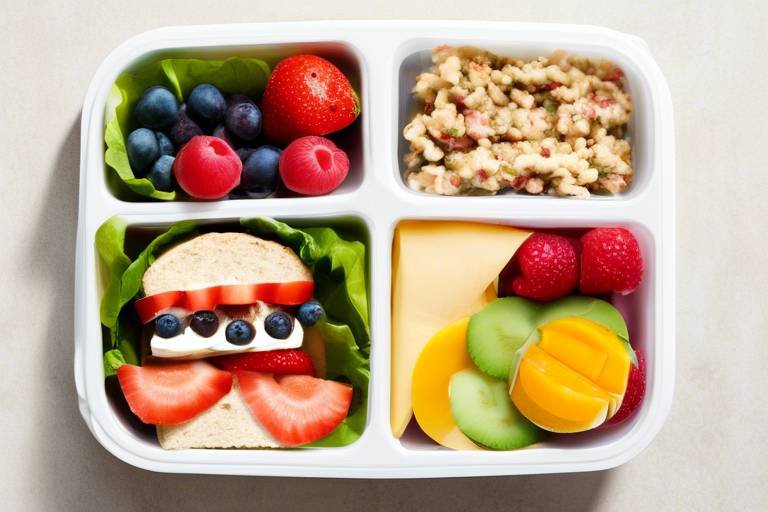How to Create a Balanced Plate for Every Family Member
In today's fast-paced world, ensuring that every family member receives the right nutrients can feel like a daunting task. However, creating a balanced plate is not only essential for health but can also be a fun and engaging process for the whole family. A balanced plate means incorporating a variety of food groups, each playing a vital role in our overall well-being. To get started, let’s dive into the principles of balanced nutrition and explore practical tips for crafting meals that cater to the diverse dietary needs of each family member.
A balanced plate includes a mix of proteins, carbohydrates, and fats, along with a colorful array of fruits and vegetables. Each food group contributes different essential nutrients that support bodily functions. For instance, proteins are crucial for building and repairing tissues, while carbohydrates provide the energy needed for daily activities. Fats, especially healthy ones, are vital for brain health and hormone production. By understanding the role of each group, you can ensure that meals are not only satisfying but also nourishing.
One of the key aspects of a balanced diet is managing portion sizes. These sizes vary significantly by age, activity level, and individual health goals. For children, the portions should be smaller, focusing on nutrient density to support their growth and development. In contrast, adults may require larger portions based on their energy expenditure. Learning to adjust portion sizes can help maintain a healthy diet while preventing overeating. This is especially important in a family setting where everyone has different needs.
Children's nutritional needs differ significantly from adults, and understanding appropriate serving sizes for them is crucial. A general guideline is to offer them a portion that is about a quarter of an adult's serving. For example, if an adult has a cup of pasta, a child might have just half a cup. This method not only ensures they get enough nutrients but also helps them learn about portion control. Here’s a quick reference table for children's serving sizes:
| Food Group | Recommended Serving Size |
|---|---|
| Fruits | 1/2 cup (fresh or canned) |
| Vegetables | 1/2 cup (cooked or raw) |
| Grains | 1/2 cup (cooked) |
| Protein | 2-3 ounces |
Different age groups require varying amounts of nutrients. For instance, toddlers may need more healthy fats for brain development, while older children may require more protein to support their growing muscles. Familiarizing yourself with age-specific guidelines can ensure that children receive the right balance of vitamins and minerals. The USDA’s MyPlate is a fantastic resource for understanding these needs.
Teaching children about healthy portions encourages them to make better food choices. It’s all about creating an environment where healthy eating is the norm. You can involve them in meal planning and preparation, turning it into a fun family activity. Positive reinforcement and education can foster lifelong healthy eating habits. For example, if your child tries a new vegetable, celebrate that choice with praise!
Adults require different portions based on activity level and health goals. If you’re active, you might need larger portions to fuel your workouts, while someone with a more sedentary lifestyle may need smaller servings. Understanding these needs can help create meals that support overall health and wellness. A good rule of thumb is to fill half your plate with vegetables, a quarter with lean protein, and a quarter with whole grains.
Diversity in food choices enhances nutrition and prevents meal fatigue. Exploring different foods can keep family meals exciting while ensuring a wide range of nutrients. Incorporating a variety of colors on your plate is not just visually appealing but also ensures a broader spectrum of vitamins and minerals. Think of your plate as a canvas – the more colors, the better!
Trying various cuisines can introduce new ingredients and flavors. This exploration can enhance family meals and make healthy eating more enjoyable. For example, you might try a Mediterranean night with quinoa, chickpeas, and fresh vegetables, or an Asian-inspired meal with brown rice and stir-fried veggies. The options are endless, and your taste buds will thank you!
Utilizing seasonal and local produce not only supports health but also promotes sustainability. Incorporating these foods can enhance meal quality and support local economies. When fruits and vegetables are in season, they are often fresher, tastier, and more nutrient-dense. Plus, shopping at local farmers' markets can be a fun family outing!
- What is a balanced plate? A balanced plate includes a variety of food groups: proteins, carbohydrates, healthy fats, fruits, and vegetables.
- How can I ensure my child is eating the right portions? Use age-appropriate serving sizes and involve them in meal planning to teach them about healthy choices.
- Why is it important to incorporate food variety? A varied diet helps prevent meal fatigue and ensures a wide range of nutrients are consumed.
- How can I introduce new cuisines to my family? Plan themed dinner nights where you explore different cultures and their culinary traditions.

Understanding Nutritional Balance
When it comes to creating a balanced plate, the first step is understanding what nutritional balance truly means. Imagine your plate as a canvas and the food groups as vibrant colors. Each group plays a unique role in painting a picture of health for your family. A balanced plate typically consists of fruits, vegetables, grains, protein, and dairy. By incorporating these elements, you can ensure that you're providing essential nutrients that support growth, development, and overall well-being.
Each food group contributes different vitamins and minerals that are crucial for health. For instance, fruits and vegetables are packed with fiber, vitamins, and antioxidants that help boost the immune system and keep our bodies functioning optimally. Meanwhile, whole grains provide necessary carbohydrates for energy, proteins are vital for muscle repair and growth, and dairy products offer calcium for strong bones. Balancing these components can feel like a juggling act, but once you get the hang of it, it becomes second nature.
To make this concept a bit clearer, let’s break down the components of a balanced plate:
| Food Group | Key Nutrients | Examples |
|---|---|---|
| Fruits | Vitamins, Fiber | Apples, Bananas, Berries |
| Vegetables | Vitamins, Minerals, Fiber | Broccoli, Spinach, Carrots |
| Grains | Carbohydrates, Fiber | Brown Rice, Quinoa, Oats |
| Protein | Amino Acids, Iron | Chicken, Beans, Tofu |
| Dairy | Calcium, Vitamin D | Milk, Yogurt, Cheese |
By understanding the significance of each food group, you can craft meals that not only satisfy hunger but also nourish the body. Think of it as building a house; each food group is a cornerstone that supports the structure of good health. Without a solid foundation, the house may crumble. Similarly, neglecting one or more food groups can lead to nutritional deficiencies and health issues over time.
It's also essential to recognize that nutritional needs can vary from person to person. Factors such as age, gender, activity level, and health conditions all play a role in determining what a balanced plate looks like for each family member. For example, children may require more energy-dense foods for growth, while adults might need to focus on maintaining a healthy weight. This is where the art of meal planning comes into play.
Incorporating a variety of foods not only enhances nutritional balance but also keeps meals exciting. Think of it like a colorful garden; the more diverse the plants, the more beautiful and robust the garden becomes. By exploring different cuisines and seasonal ingredients, you can introduce new flavors and textures that make healthy eating a delightful experience for the entire family.

Portion Control for All Ages
When it comes to maintaining a healthy diet, portion control plays a pivotal role, especially for families with members of varying ages and activity levels. Understanding how much food each person needs can be a game changer in promoting overall health and well-being. It's like finding the perfect balance on a seesaw—too much on one side, and it tips over! The key is to tailor portions to fit the unique needs of each family member, ensuring that everyone gets the nutrients they need without the risk of overeating.
For children, the journey of developing healthy eating habits begins at home. Their nutritional needs are quite different from adults, primarily because they are still growing and developing. A child’s plate should ideally be filled with colorful fruits, vegetables, whole grains, and lean proteins. But how do we determine the right portion sizes? One effective strategy is to use the plate method, which suggests filling half the plate with fruits and vegetables, one-quarter with whole grains, and one-quarter with protein. This visual guide helps parents create balanced meals that are not only nutritious but also visually appealing to young eaters.
To further illustrate portion control for children, consider the following age-specific guidelines:
| Age Group | Recommended Serving Size | Food Groups |
|---|---|---|
| 2-3 years | 1/2 cup | Fruits, Vegetables |
| 4-8 years | 1/2 - 1 cup | Grains, Protein |
| 9-13 years | 1-1.5 cups | Fruits, Vegetables |
As children grow, their caloric needs increase, and so does their ability to understand healthy portions. This is where education comes into play. Teaching kids about healthy choices can empower them to make informed decisions about their food. For instance, when they are involved in meal planning or preparation, they become more aware of what goes into their bodies. It’s like giving them the keys to a treasure chest of health!
Now, let's not forget about adults. Portion sizes for adults can vary significantly based on factors like activity level and individual health goals. For example, an athlete may require larger portions to fuel their workouts, while someone aiming to lose weight might opt for smaller servings. It's essential to listen to your body's hunger signals and adjust portions accordingly. A practical tip is to use smaller plates—this simple trick can make a big difference in how much food you serve yourself and, ultimately, consume.
In conclusion, mastering portion control is a vital skill for every family member, regardless of age. By understanding the unique needs of children and adults alike, families can create meals that nourish, satisfy, and promote healthy eating habits. Remember, it’s not just about what’s on the plate but also how much of it is there. With a little mindfulness and creativity, every meal can be a step toward a healthier lifestyle.
- How can I teach my children about portion control? Start by involving them in meal prep and using visual aids like the plate method to demonstrate balanced meals.
- What are some signs of overeating? Signs include feeling overly full, sluggish, or experiencing discomfort after meals.
- Are there specific portion sizes for snacks? Yes! Snacks should be smaller than meal portions, typically around a handful or 1/4 of a plate.

Serving Sizes for Children
When it comes to feeding children, understanding appropriate serving sizes is crucial for their growth and development. Unlike adults, children's bodies are still growing, and their nutritional needs can vary significantly based on age, activity level, and overall health. So, how do we ensure that our little ones are getting just the right amount of food without overwhelming their small stomachs? It's all about balance and making informed choices!
Generally, serving sizes for children are smaller than those for adults, but they still need a variety of nutrients to thrive. For instance, a healthy plate for a child should ideally include:
- Fruits and Vegetables: Aim for half of the plate to be filled with colorful fruits and vegetables. This not only makes the meal visually appealing but also packs it with essential vitamins and minerals.
- Grains: Whole grains should make up about a quarter of the plate. Think brown rice, whole wheat pasta, or quinoa—these are great energy sources!
- Protein: The remaining quarter should consist of lean proteins such as chicken, fish, beans, or tofu. These are vital for muscle growth and repair.
To give you a clearer picture of what serving sizes look like for children, here’s a simple table:
| Food Group | Recommended Serving Size |
|---|---|
| Fruits | 1/2 cup (fresh or canned) |
| Vegetables | 1/2 cup (cooked) or 1 cup (raw) |
| Grains | 1/4 to 1/2 cup (cooked) |
| Protein | 1 ounce (meat) or 1/4 cup (beans) |
But remember, these are just guidelines! Each child is unique, and their appetites can fluctuate from day to day. It’s important to listen to their hunger cues. Are they asking for more? Or are they pushing their plate away? These signals can help you adjust portion sizes accordingly.
Moreover, teaching children about healthy portions can set the stage for lifelong healthy eating habits. Involving them in meal prep, explaining why certain foods are beneficial, and allowing them to serve themselves can empower them to make better choices. After all, wouldn’t it be wonderful if they grew up with a healthy relationship with food?
In conclusion, serving sizes for children are not just about quantity; they are about quality, variety, and education. By providing balanced meals that cater to their unique needs, we can help our children flourish and develop a love for nutritious foods that last a lifetime.
Q: How do I know if my child is eating enough?
A: Monitor their growth and energy levels. If they are active and growing at a healthy rate, they are likely getting enough nutrition.
Q: Should I force my child to finish their plate?
A: It's better to encourage them to listen to their bodies. Forcing them to eat can create negative associations with food.
Q: What if my child is a picky eater?
A: Try to offer a variety of foods and involve them in meal planning. Sometimes, kids need to see a food multiple times before they are willing to try it.
Q: How can I make healthy eating fun for my child?
A: Get creative! Use cookie cutters to shape fruits and veggies, or create fun names for dishes. Making food fun can help children be more excited about healthy options.

Age-Specific Guidelines
When it comes to nutrition, one size definitely does not fit all. are essential for ensuring that each family member gets the right balance of nutrients tailored to their unique needs. For instance, infants require a diet rich in fats for brain development, while teenagers need increased calories and protein to support their growth spurts. Understanding these differences can empower parents to make informed choices when planning meals.
To illustrate the varying nutritional requirements across different age groups, let's break it down into some key stages:
| Age Group | Key Nutritional Needs |
|---|---|
| Infants (0-12 months) | High fat intake for brain development; iron-rich foods after 6 months. |
| Toddlers (1-3 years) | Balanced diet with a focus on healthy fats, fruits, vegetables, and whole grains. |
| Children (4-12 years) | Increased protein and calcium for bone growth; variety of fruits and vegetables. |
| Teenagers (13-19 years) | Higher caloric intake; focus on protein, calcium, and iron due to rapid growth. |
| Adults (20 years and older) | Balanced diet with appropriate caloric intake based on activity level; focus on fiber and healthy fats. |
By familiarizing yourself with these guidelines, you can ensure that each family member receives the right balance of vitamins and minerals. For example, while toddlers may need a higher percentage of fats in their diet, adults benefit from a focus on fiber and whole grains to maintain digestive health. It’s like tuning a musical instrument; each age group has its own unique melody that needs to be played just right!
Furthermore, encouraging healthy eating habits from a young age can set the stage for lifelong wellness. Teaching children about the importance of nutrition and how different foods affect their bodies can empower them to make better choices. You might consider involving them in meal planning or cooking; this not only educates them but also makes them more excited about eating healthy.
In conclusion, keeping these in mind while planning meals will help ensure that your family is not just eating, but thriving. After all, a well-nourished family is a happy family!
- What are the main food groups I should include in my family's diet? A balanced diet should include fruits, vegetables, grains, protein sources, and dairy or dairy alternatives.
- How can I encourage my children to try new foods? Involve them in meal preparation and make it a fun experience. Offer small portions of new foods alongside familiar favorites.
- Are there specific foods that should be avoided for certain age groups? Yes, for instance, honey should be avoided for infants under one year due to the risk of botulism.

Encouraging Healthy Choices
Encouraging healthy choices in children is not just about telling them what to eat; it’s about creating an environment where nutritious foods are accessible and appealing. Imagine your kitchen as a vibrant garden of options, where fruits and vegetables are the flowers that bloom every day. When kids see colorful, healthy foods readily available, they're more likely to reach for them instead of sugary snacks or processed foods. It’s all about making the right choices the easiest choices!
One effective strategy is to involve children in the meal planning and preparation process. When they help pick out fruits and vegetables at the grocery store or assist in cooking, they develop a sense of ownership over their meals. This not only makes them more likely to try new foods but also teaches them valuable skills. You might say, “Hey, let’s make a colorful salad together!” Suddenly, they’re excited about eating greens because they had a hand in creating it.
Moreover, education plays a crucial role. Kids are naturally curious, and teaching them about the benefits of healthy eating can make a world of difference. You can explain how certain foods help them grow strong or improve their focus in school. For instance, you might say, “Did you know that carrots can help you see better in the dark?” This kind of fun, informative dialogue can spark their interest in healthy choices.
Positive reinforcement is another powerful tool. Celebrate small victories when they choose a healthy option. Instead of focusing solely on what they shouldn't eat, highlight the deliciousness of nutritious foods. You could say, “Wow, you chose an apple instead of chips! That’s awesome! Let’s slice it up and add some peanut butter.” This approach not only encourages them to make healthy choices but also builds their confidence in selecting nutritious foods.
Here’s a quick table summarizing some practical tips to encourage healthy eating habits:
| Tip | Description |
|---|---|
| Involve Kids | Let them help with grocery shopping and meal prep. |
| Educate | Teach them about the benefits of healthy foods. |
| Positive Reinforcement | Celebrate their healthy choices with praise and excitement. |
| Make it Fun | Turn meals into a fun activity, like creating colorful plates. |
Lastly, consider making healthy eating a family affair. When everyone participates in choosing and preparing meals, it fosters a sense of community and shared responsibility. You can even have a “healthy eating challenge” where each family member tries a new fruit or vegetable each week. This not only keeps things exciting but also reinforces the idea that healthy eating can be fun!
In conclusion, encouraging healthy choices in children is a multifaceted approach that combines accessibility, education, positive reinforcement, and family involvement. By creating a supportive environment and making nutrition engaging, you can help your children develop lifelong healthy eating habits that will benefit them for years to come.
- How can I make healthy foods more appealing to my kids? Try making meals colorful and fun, and involve them in the cooking process.
- What are some easy healthy snacks for kids? Fresh fruits, yogurt, and whole-grain crackers are great options.
- How can I educate my children about nutrition? Use fun facts, involve them in meal planning, and encourage questions about food.

Serving Sizes for Adults
When it comes to , understanding the balance between portion control and nutritional needs is crucial. Adults typically have varying requirements based on factors such as age, gender, activity level, and overall health goals. For instance, a sedentary adult may need fewer calories compared to someone who exercises regularly. This means that a one-size-fits-all approach simply doesn’t cut it in the world of nutrition.
To illustrate this, let’s break down the recommended daily serving sizes for different food groups. According to the USDA, a balanced diet for adults generally includes:
| Food Group | Recommended Daily Servings |
|---|---|
| Fruits | 1.5 to 2 cups |
| Vegetables | 2 to 3 cups |
| Grains | 6 to 8 ounces |
| Protein | 5 to 6.5 ounces |
| Dairy | 3 cups |
Now, you might be wondering how to translate these servings into real meals. Think about it like building a delicious puzzle. Each piece, or food group, has a specific role in creating a complete picture of nutrition. For example, if you’re preparing a dinner plate, you might want to fill half of it with colorful vegetables and fruits, a quarter with lean protein, and the remaining quarter with whole grains. This not only ensures a variety of nutrients but also keeps your meals visually appealing and satisfying.
It’s also important to consider individual dietary needs. For example, someone aiming to lose weight might focus on smaller portions of high-calorie foods, while an athlete might require larger servings to fuel their active lifestyle. Listening to your body’s hunger cues and adjusting portions accordingly can be a game changer in maintaining a healthy diet.
Another tip is to utilize measuring tools to help gauge portion sizes. Using measuring cups or a food scale can provide a more accurate idea of how much you're consuming. However, it’s also essential to develop an intuitive sense of portion sizes over time. For instance, a serving of protein should be about the size of your palm, while a serving of grains could be roughly the size of a fist. This way, you can enjoy your meals without constantly relying on measuring tools.
Incorporating mindful eating practices can also play a significant role in managing portion sizes. This means taking the time to savor your food, paying attention to flavors and textures, and recognizing when you’re truly full. It’s amazing how much more satisfying a meal can be when you’re fully present during the eating experience!
Ultimately, finding the right serving sizes for adults is about balance and personalization. By understanding your unique nutritional needs and being mindful of portion control, you can create meals that not only nourish your body but also delight your taste buds. So, the next time you sit down to eat, remember: it's not just about filling your plate; it's about crafting a meal that supports your health and well-being.
- What is the best way to control portion sizes? - Start by using smaller plates and bowls, and pay attention to your body's hunger signals.
- How can I ensure I'm getting enough nutrients? - Aim for a variety of foods from each food group, and consider consulting a nutritionist for personalized advice.
- Are there any tools to help with portion control? - Yes! Measuring cups, food scales, and portion control plates can be very helpful.

Incorporating Food Variety
When it comes to crafting meals that not only satisfy but also nourish, variety is the spice of life. Incorporating a diverse range of foods into your family's diet can significantly enhance nutritional intake while keeping mealtime exciting. Imagine your plate as a colorful palette, where each hue represents a different food group. This vibrant approach not only appeals to the eyes but also ensures that you're getting a wide array of essential nutrients.
One of the biggest benefits of food variety is the prevention of meal fatigue. Eating the same foods day in and day out can lead to boredom, making it all too easy to stray from healthy eating habits. By exploring different cuisines and ingredients, you can keep your meals fresh and engaging. For instance, you might try a Mediterranean quinoa salad one day and a spicy Thai stir-fry the next. Each dish introduces new flavors, textures, and nutrients, making healthy eating feel less like a chore and more like an adventure.
Moreover, seasonal and local foods play a crucial role in incorporating variety. Not only do they taste better, but they also pack more nutrients since they are harvested at their peak. Supporting local farmers by choosing seasonal produce can also be a fun family activity. Consider visiting a local farmer's market together; it’s a fantastic way to teach kids about where their food comes from and the importance of eating fresh. Plus, you'll likely discover unique ingredients that can inspire new recipes!
When planning meals, aim to include foods from all the major food groups: fruits, vegetables, grains, proteins, and dairy. A well-rounded plate might look like this:
| Food Group | Examples | Benefits |
|---|---|---|
| Fruits | Apples, Berries, Bananas | Rich in vitamins, antioxidants, and fiber. |
| Vegetables | Spinach, Carrots, Bell Peppers | Low in calories, high in nutrients. |
| Grains | Brown Rice, Quinoa, Whole Wheat Pasta | Provide energy and essential nutrients. |
| Proteins | Chicken, Tofu, Beans | Supports muscle growth and repair. |
| Dairy | Yogurt, Cheese, Milk | Good source of calcium and vitamin D. |
Incorporating variety doesn’t have to be overwhelming. Start by setting a goal to try one new recipe or ingredient each week. This can be a fun family challenge—everyone can take turns choosing what to try! Not only does this approach introduce new foods, but it also fosters a sense of teamwork and excitement around meals.
In conclusion, embracing food variety is essential for maintaining a balanced diet and keeping family meals enjoyable. By experimenting with different cuisines, prioritizing seasonal and local ingredients, and ensuring a mix of food groups on your plate, you’ll not only enhance nutrition but also create lasting memories around the dinner table.
- Why is it important to have a variety of foods in my diet?
A diverse diet helps ensure you receive all the essential nutrients your body needs to function optimally. - How can I encourage my children to try new foods?
Make it a fun family activity by trying new recipes together and involving them in the cooking process. - What are some easy ways to incorporate seasonal produce into meals?
Visit local farmers' markets, join a community-supported agriculture (CSA) program, or subscribe to a seasonal produce delivery service.

Exploring Different Cuisines
When it comes to feeding your family, variety is the spice of life. Exploring different cuisines not only adds excitement to your meals but also opens the door to a world of flavors, textures, and nutritional benefits. Think of it as a culinary adventure where each dish tells a story. Have you ever wondered how a simple ingredient can transform when prepared in a different way? For instance, consider how tomatoes are used in Italian pasta sauces versus Moroccan tagines. Both are delicious but offer unique tastes and health benefits!
Venturing into various culinary traditions allows you to incorporate a wide array of ingredients, ensuring that your family receives a balanced diet. From the vibrant spices of Indian cuisine to the fresh herbs in Mediterranean dishes, each culinary culture emphasizes different food groups and cooking techniques. This not only enhances the nutritional profile of your meals but also keeps your family engaged and excited about what’s for dinner.
One of the best ways to start this exploration is by trying out new recipes from different regions. You might be surprised by how easy it is to whip up a delicious Thai curry or a hearty Mexican bean stew. Here are a few cuisines to consider:
- Italian: Think whole grains, fresh vegetables, and healthy fats from olive oil. Dishes like caprese salad or whole wheat pasta with veggies can be both nutritious and satisfying.
- Japanese: Emphasizing fish, rice, and vegetables, Japanese cuisine offers a balanced approach. Sushi rolls packed with fresh veggies and fish are a fun way to introduce new flavors.
- Indian: Known for its rich spices, Indian cuisine can be both flavorful and healthy. Lentil dishes like dal are high in protein and fiber, making them a great addition to any meal.
As you consider these options, don't forget about the benefits of seasonal and local ingredients. Not only are they often fresher and more flavorful, but using them also supports local farmers and reduces your carbon footprint. Imagine the difference in taste between a tomato picked at its peak ripeness from a local market versus one shipped from thousands of miles away!
Incorporating different cuisines into your family meals can also be a wonderful opportunity for education. You can teach your children about the cultures behind the dishes, discussing the ingredients and cooking methods. This not only makes mealtime more interesting but also fosters an appreciation for diversity and culinary arts. So, next time you're planning your weekly menu, why not challenge yourself to include a dish from a different cuisine? It could be the start of a delicious family tradition!
Q: How can I introduce different cuisines to my family?
A: Start by selecting one new cuisine each week. Research simple recipes together, shop for the ingredients, and cook as a family. Make it a fun learning experience!
Q: Are there specific health benefits to exploring different cuisines?
A: Yes! Different cuisines often emphasize various food groups and cooking methods, which can enhance nutrient diversity in your diet. For example, Mediterranean diets are rich in healthy fats, while Asian cuisines may focus more on whole grains and vegetables.
Q: What if my family is picky about trying new foods?
A: Encourage them to take small steps. Start with familiar ingredients prepared in new ways, and gradually introduce more exotic flavors. Make it a fun challenge to try something new each week!

Seasonal and Local Foods
Have you ever noticed how fresh produce just tastes better when it’s in season? That’s because seasonal foods are picked at their peak ripeness, bursting with flavor and nutrients. Eating with the seasons not only satisfies your taste buds but also aligns your meals with nature’s rhythm. Imagine enjoying juicy tomatoes in the summer or hearty squash in the fall. It’s like a culinary calendar that guides your plate throughout the year!
Incorporating local foods into your family's meals is another fantastic way to boost nutrition while supporting your community. When you buy local, you’re often getting produce that hasn't traveled far, which means it’s fresher and retains more nutrients. Plus, you’re helping local farmers thrive. It’s a win-win! Think of it as a delicious circle of life where every bite supports the earth and the people in your neighborhood.
But how do you start? First, visit your local farmers' market! These vibrant hubs are filled with colorful fruits and vegetables, often grown just a few miles away. You might even discover unique varieties that you won’t find in the supermarket. Engaging with local farmers also gives you the chance to learn about their growing practices, and you can ask questions about how to best prepare their produce. It’s like a mini-adventure for your taste buds!
Another great tip is to look for community-supported agriculture (CSA) programs. By subscribing to a CSA, you can receive a box of fresh, seasonal produce delivered right to your doorstep. This not only ensures you’re eating what’s in season, but it also encourages you to try new ingredients. You might even find a new family favorite! Plus, it’s an exciting surprise each week, like a treasure hunt for your kitchen.
Here’s a quick table to illustrate some examples of seasonal produce:
| Season | Fruits | Vegetables |
|---|---|---|
| Spring | Strawberries, Rhubarb | Asparagus, Spinach |
| Summer | Tomatoes, Peaches | Zucchini, Bell Peppers |
| Autumn | Apples, Pears | Squash, Brussels Sprouts |
| Winter | Citrus Fruits, Pomegranates | Root Vegetables, Cabbage |
Incorporating seasonal and local foods into your family meals can be a delightful journey. Not only will you be nourishing your family with wholesome ingredients, but you’ll also be fostering a deeper connection with your food and community. So, the next time you plan your meals, consider what’s in season and local. It’s like inviting a little piece of nature onto your plate!
- Why should I eat seasonal foods? Eating seasonal foods ensures you get the freshest, most flavorful produce, packed with nutrients.
- How do I find local produce? Visit farmers' markets, join CSA programs, or check local grocery stores that source from local farms.
- Can seasonal eating save money? Yes! Seasonal produce is often less expensive due to greater availability, which can help you save on your grocery bill.
Frequently Asked Questions
- What is a balanced plate?
A balanced plate is a meal that includes a variety of food groups, ensuring that you get the right nutrients needed for health. It typically consists of fruits, vegetables, whole grains, proteins, and healthy fats, all proportioned to meet individual dietary needs.
- How do I know the right portion sizes for my family?
Portion sizes can vary based on age, activity level, and individual health goals. For children, smaller portions are usually sufficient, while adults may require larger servings. A good rule of thumb is to fill half the plate with fruits and vegetables, a quarter with lean protein, and a quarter with whole grains.
- What are age-specific guidelines for children's nutrition?
Children's nutritional needs change as they grow. Infants require nutrient-dense foods, while toddlers and preschoolers need balanced meals with appropriate serving sizes. School-aged children and teenagers need more calories and nutrients to support their growth and activity levels. Familiarizing yourself with these guidelines can help you provide balanced meals.
- How can I encourage my kids to make healthy food choices?
Teaching children about healthy eating can be fun! Involve them in meal planning and preparation, and use positive reinforcement to celebrate their healthy choices. Make it a game or a family activity to explore new foods together, which can help them develop a positive relationship with nutrition.
- Why is food variety important in our meals?
Diversity in food choices not only enhances nutrition but also keeps meals exciting. By exploring different cuisines and incorporating seasonal produce, you can introduce new flavors and nutrients to your family's diet, preventing meal fatigue and encouraging adventurous eating.
- How can seasonal and local foods improve our meals?
Using seasonal and local foods can enhance the quality of your meals by providing fresher ingredients that are often more nutritious. Plus, it supports local farmers and reduces the environmental impact of transporting food long distances. It’s a win-win for your health and the planet!



















